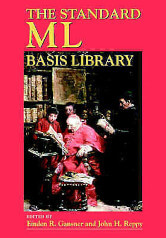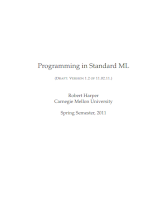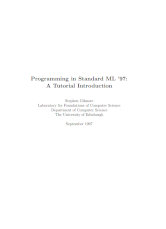Last Updated on May 22, 2022
4. The Standard ML Basis Library by Emden R. Gansner and John H. Reppy
 Standard ML is an influential programming language that represents many state-of-the-art aspects of language design in a form usable for everyday programming. The language is in use worldwide, with applications ranging from network communication to theorem proving.
Standard ML is an influential programming language that represents many state-of-the-art aspects of language design in a form usable for everyday programming. The language is in use worldwide, with applications ranging from network communication to theorem proving.
The definition for SML’s standard library, this work concisely describes the types and functions defined in the library and discusses in depth the library’s design and use. This manual will be an indispensable reference for students, professional programmers, and language designers.
The book serves as a programmer’s reference, providing manual pages with concise descriptions. In addition, it presents the principles and rationales used in designing the library, and relates these to idioms and examples for using the library. A particular emphasis of the library is to encourage the use of SML in serious system programming. Major features of the library include I/O, a large collection of primitive types, support for internationalization, and a portable operating system interface.
This manual will be an indispensable reference for students, professional programmers, and language designers.
5. Programming in Standard ML by Robert Harper

These notes are intended as a brief introduction to Standard ML (1997 dialect) for the experienced programmer. They began as lecture notes for 15-212: Fundamental Principles of Computer Science II, the second semester of the introductory sequence in the undergraduate computer science curriculum at Carnegie Mellon University. They have subsequently been used in several other courses at Carnegie Mellon, and at a number of universities around the world. These notes are intended to supersede the author’s Introduction to Standard ML.
The emphasis of this book is on informal derivation of examples that show both correct and incorrect approaches. It shows functional language as a practical tool for software design and contains real life examples to allow for large scale software engineering issues.
This work is licensed under the Creative Commons Attribution-Noncommercial-No Derivative Works 3.0 United States License.
6. Programming in Standard ML ’97: A Tutorial Introduction by Stephen Gilmore
 Standard ML is a programming language which combines the elegance of functional programming with the effectiveness of imperative programming.
Standard ML is a programming language which combines the elegance of functional programming with the effectiveness of imperative programming.
This tutorial introduces important concepts in the language, illustrating them with brief examples.
These are the lecture notes from an eighteen lecture Master of Science course given in the Department of Computer Science at The University of Edinburgh between 1992 and 1997.
Pages in this article:
Page 1 – ML for the Working Programmer and more books
Page 2 – The Standard ML Basis Library and more books
All books in this series:
| Free Programming Books | |
|---|---|
| Ada | ALGOL-like programming language, extended from Pascal and other languages |
| Agda | Dependently typed functional language based on intuitionistic Type Theory |
| Arduino | Inexpensive, flexible, open source microcontroller platform |
| Assembly | As close to writing machine code without writing in pure hexadecimal |
| Awk | Versatile language designed for pattern scanning and processing language |
| Bash | Shell and command language; popular both as a shell and a scripting language |
| BASIC | Beginner’s All-purpose Symbolic Instruction Code |
| C | General-purpose, procedural, portable, high-level language |
| C++ | General-purpose, portable, free-form, multi-paradigm language |
| C# | Combines the power and flexibility of C++ with the simplicity of Visual Basic |
| Clojure | Dialect of the Lisp programming language |
| ClojureScript | Compiler for Clojure that targets JavaScript |
| COBOL | Common Business-Oriented Language |
| CoffeeScript | Transcompiles into JavaScript inspired by Ruby, Python and Haskell |
| Coq | Dependently typed language similar to Agda, Idris, F* and others |
| Crystal | General-purpose, concurrent, multi-paradigm, object-oriented language |
| CSS | CSS (Cascading Style Sheets) specifies a web page’s appearance |
| D | General-purpose systems programming language with a C-like syntax |
| Dart | Client-optimized language for fast apps on multiple platforms |
| Dylan | Multi-paradigm language supporting functional and object-oriented coding |
| ECMAScript | Best known as the language embedded in web browsers |
| Eiffel | Object-oriented language designed by Bertrand Meyer |
| Elixir | Relatively new functional language running on the Erlang virtual machine |
| Erlang | General-purpose, concurrent, declarative, functional language |
| F# | Uses functional, imperative, and object-oriented programming methods |
| Factor | Dynamic stack-based programming language |
| Forth | Imperative stack-based programming language |
| Fortran | The first high-level language, using the first compiler |
| Go | Compiled, statically typed programming language |
| Groovy | Powerful, optionally typed and dynamic language |
| Haskell | Standardized, general-purpose, polymorphically, statically typed language |
| HTML | HyperText Markup Language |
| Icon | Wide variety of features for processing and presenting symbolic data |
| J | Array programming language based primarily on APL |
| Java | General-purpose, concurrent, class-based, object-oriented, high-level language |
| JavaScript | Interpreted, prototype-based, scripting language |
| Julia | High-level, high-performance language for technical computing |
| Kotlin | More modern version of Java |
| LabVIEW | Designed to enable domain experts to build power systems quickly |
| LaTeX | Professional document preparation system and document markup language |
| Lisp | Unique features - excellent to study programming constructs |
| Logo | Dialect of Lisp that features interactivity, modularity, extensibility |
| Lua | Designed as an embeddable scripting language |
| Markdown | Plain text formatting syntax designed to be easy-to-read and easy-to-write |
| Objective-C | Object-oriented language that adds Smalltalk-style messaging to C |
| OCaml | The main implementation of the Caml language |
| Pascal | Imperative and procedural language designed in the late 1960s |
| Perl | High-level, general-purpose, interpreted, scripting, dynamic language |
| PHP | PHP has been at the helm of the web for many years |
| PostScript | Interpreted, stack-based and Turing complete language |
| Prolog | A general purpose, declarative, logic programming language |
| PureScript | Small strongly, statically typed language compiling to JavaScript |
| Python | General-purpose, structured, powerful language |
| QML | Hierarchical declarative language for user interface layout - JSON-like syntax |
| R | De facto standard among statisticians and data analysts |
| Racket | General-purpose, object-oriented, multi-paradigm, functional language |
| Raku | Member of the Perl family of programming languages |
| Ruby | General purpose, scripting, structured, flexible, fully object-oriented language |
| Rust | Ideal for systems, embedded, and other performance critical code |
| Scala | Modern, object-functional, multi-paradigm, Java-based language |
| Scheme | A general-purpose, functional language descended from Lisp and Algol |
| Scratch | Visual programming language designed for 8-16 year-old children |
| SQL | Access and manipulate data held in a relational database management system |
| Standard ML | General-purpose functional language characterized as "Lisp with types" |
| Swift | Powerful and intuitive general-purpose programming language |
| Tcl | Dynamic language based on concepts of Lisp, C, and Unix shells |
| TeX | Markup and programming language - create professional quality typeset text |
| TypeScript | Strict syntactical superset of JavaScript adding optional static typing |
| Vala | Object-oriented language, syntactically similar to C# |
| VHDL | Hardware description language used in electronic design automation |
| VimL | Powerful scripting language of the Vim editor |
| XML | Rules for defining semantic tags describing structure ad meaning |
